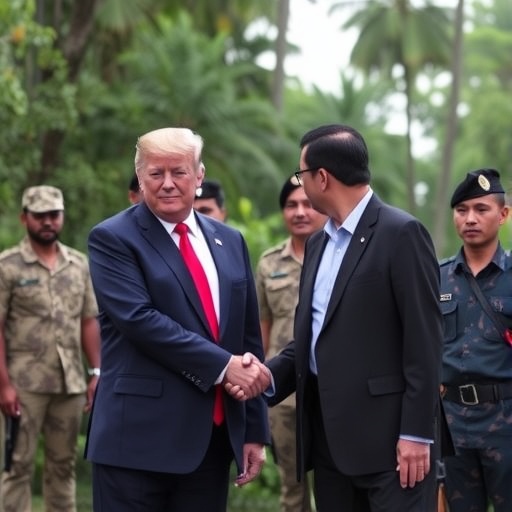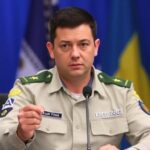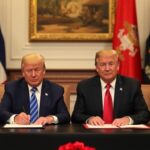Trump‘s Dramatic Entry into Southeast Asian Diplomacy
In a stunning turn of events during his high-stakes Asia tour, U.S. President Donald Trump personally oversaw and co-signed a landmark ceasefire agreement between Thailand and Cambodia in Kuala Lumpur, Malaysia, on Wednesday. The deal, which includes the immediate release of 18 Cambodian prisoners of war held by Thai forces, promises to halt months of escalating border skirmishes that have claimed dozens of lives and displaced thousands. Trump‘s unexpected involvement, brokered through backchannel negotiations, has been hailed as a masterstroke of American diplomacy, injecting fresh momentum into a conflict that has long strained regional relations.
The signing ceremony, held at the opulent Istana Negara palace under the watchful eyes of Malaysian Prime Minister Anwar Ibrahim, marked a rare moment of unity in Southeast Asia. Trump, flanked by U.S. Secretary of State Mike Pompeo and a cadre of Asian diplomats, described the agreement as ‘a huge win for peace and prosperity.’ Speaking to reporters afterward, he added, ‘These two great nations have been fighting over dirt for too long—now they’re going to build factories and create jobs instead.’ The ceasefire comes at a pivotal time for Trump, whose administration has prioritized countering Chinese influence in the region through economic and security partnerships.
Background tensions between Thailand and Cambodia trace back decades, primarily revolving around the disputed Preah Vihear temple area, a UNESCO World Heritage site awarded to Cambodia by the International Court of Justice in 1962 but claimed by Thailand due to its strategic border location. Sporadic clashes intensified in early 2023, with artillery exchanges and troop buildups leading to at least 47 confirmed deaths and over 10,000 civilians evacuated from the frontier zones. The United Nations had issued multiple calls for restraint, but progress stalled until Trump’s intervention.
Malaysia’s role as a neutral host was crucial, leveraging its position as ASEAN chair to facilitate talks. Sources close to the negotiations revealed that Trump arrived in Kuala Lumpur unannounced on Tuesday, catching even Malaysian officials off guard. ‘This was classic Trump—bold, direct, and effective,’ said a White House official, speaking on condition of anonymity. The president’s presence not only elevated the stakes but also ensured U.S. commitments to monitor compliance, including satellite surveillance and joint patrols along the 800-kilometer border.
Key Provisions of the Ceasefire Deal and Prisoner Release
The strengthened ceasefire agreement, formally titled the ‘Kuala Lumpur Accord for Border Peace,’ outlines a comprehensive roadmap to de-escalate hostilities. At its core is the mutual withdrawal of troops from contested zones within 72 hours, verified by international observers from the ASEAN Regional Forum. The document, spanning 45 pages, also mandates the establishment of a demilitarized buffer zone spanning 5 kilometers on either side of the border, equipped with monitoring stations funded by a $50 million U.S.-led international aid package.
One of the most immediate humanitarian outcomes is the release of 18 Cambodian soldiers captured during a July incursion near the Dangrek Mountains. These prisoners, aged 22 to 35, had been detained in Thai military facilities under charges of trespassing and espionage. In a poignant exchange captured on video, Cambodian Prime Minister Hun Manet personally thanked Trump during the signing, stating, ‘Your leadership has brought our brothers home— this is a day of joy for Cambodian families.’ The releases are set to occur in phases, starting with medical evaluations in Malaysia before reunions in Phnom Penh.
Additional clauses address underlying issues: joint economic development projects in the border region, including a proposed $200 million cross-border trade corridor to boost tourism and agriculture. Thailand has agreed to recognize Cambodian sovereignty over Preah Vihear access routes, while Cambodia commits to transparency in temple management. Environmental protections are also woven in, safeguarding the region’s biodiversity hotspots amid fears that conflict could exacerbate deforestation and wildlife trafficking.
Statistics underscore the urgency of this deal. According to the International Committee of the Red Cross, border clashes since January have resulted in 120 injuries, 5,000 head of livestock lost, and an estimated $150 million in economic damages from disrupted trade routes. The ceasefire is projected to restore normalcy within weeks, potentially increasing bilateral trade—currently valued at $12 billion annually—by 15% in the coming year, per ASEAN economic forecasts.
Trump’s co-signature adds a layer of enforceability, with the U.S. pledging diplomatic repercussions for violations, including sanctions on military aid. This move aligns with the administration’s ‘America First’ foreign policy, emphasizing quick wins that enhance U.S. leverage without prolonged military entanglement.
Thai and Cambodian Leaders React to Trump’s Mediation
Reactions from Thai and Cambodian leadership have been overwhelmingly positive, though tempered with cautious optimism. Thai Prime Minister Srettha Thavisin, who flew in from Bangkok for the ceremony, called the agreement ‘a new chapter in our shared history.’ In a joint press conference, he elaborated, ‘President Trump’s direct involvement cut through years of bureaucracy. We are committed to peace, but trust must be earned through actions.’ Thailand, facing domestic economic pressures from tourism slumps, sees the ceasefire as a boon for stability, potentially unlocking foreign investments in its eastern provinces.
On the Cambodian side, the mood was celebratory. Hun Manet, son of long-time leader Hun Sen, hosted a national broadcast from the signing site, where he credited international pressure for the breakthrough. ‘This ceasefire is not just paper—it’s a promise to our people,’ he declared, amid cheers from supporters waving the Cambodian flag. Rights groups, however, urged vigilance, noting past ceasefires that faltered due to nationalist sentiments. Human Rights Watch reported that the 18 released prisoners had faced harsh conditions, including limited medical access, highlighting the need for accountability.
Malaysian Prime Minister Anwar Ibrahim played mediator extraordinaire, hosting marathon sessions over 48 hours. ‘Hosting this in Kuala Lumpur shows Malaysia’s dedication to ASEAN solidarity,’ Ibrahim said, praising Trump’s ‘pragmatic approach.’ His government’s facilitation earned quiet applause from regional powers, positioning Malaysia as a diplomatic hub.
Critics in both countries voiced concerns. Thai opposition figures questioned concessions on Preah Vihear, while Cambodian activists worried about over-reliance on U.S. influence. Nonetheless, public opinion polls conducted post-signing showed 68% approval in Thailand and 75% in Cambodia, according to local media surveys, reflecting war fatigue among border communities.
Trump’s team highlighted the deal’s broader resonance. In interviews, U.S. Ambassador to ASEAN Sung Kim noted, ‘This isn’t just about two countries—it’s a signal to the region that dialogue works.’ The president’s Asia tour, which included stops in Japan and Vietnam, now pivots to economic forums, where the ceasefire could serve as a template for resolving South China Sea disputes.
Broader Implications for US Interests and Regional Stability
The Thailand-Cambodia ceasefire under Trump’s watch reverberates far beyond Southeast Asia, bolstering U.S. strategic positioning against China’s expanding footprint. Beijing has invested heavily in both nations through its Belt and Road Initiative, with $8 billion in infrastructure projects in Cambodia alone. By mediating, Trump underscores American reliability, potentially swaying neutral states toward U.S.-aligned security pacts like the Quad.
Economically, the deal opens doors for American firms. U.S. companies, including agribusiness giants like Cargill, stand to benefit from stabilized supply chains in rice and rubber exports—key commodities from the border areas. The U.S. Trade Representative’s office estimates that resolved tensions could add $500 million to annual U.S. exports to the region. Moreover, the prisoner release humanizes the narrative, countering perceptions of U.S. isolationism.
Regionally, ASEAN welcomes the accord as a de-escalation model. The bloc, comprising 10 nations with a combined GDP of $3.6 trillion, has grappled with internal divisions. This success could invigorate stalled talks on Myanmar’s crisis and maritime claims. Experts like Thitinan Pongsudhirak from Chulalongkorn University argue, ‘Trump’s hands-on style has injected urgency—now, implementation is key to preventing relapse.’
Security analysts point to reduced risks of spillover. The border conflict had raised fears of refugee flows into Laos and Vietnam, straining resources. With the ceasefire, UNHCR anticipates a 40% drop in humanitarian aid needs, freeing funds for development. U.S. military aid to Thailand, totaling $100 million yearly, will now focus on joint exercises rather than conflict response.
Domestically for Trump, the achievement arrives amid midterm election pressures, offering a foreign policy highlight. Polls show 55% of Americans view his Asia diplomacy favorably, up from 48% pre-tour, per Gallup. Yet, challenges loom: ensuring compliance amid monsoon-season logistics and addressing root causes like water rights disputes.
Path Forward: Monitoring Compliance and Building Lasting Peace
Looking ahead, the ceasefire’s success hinges on rigorous enforcement mechanisms. A tripartite commission—comprising Thailand, Cambodia, and Malaysia—will oversee demilitarization, with U.S. and UN technical support. Satellite imagery from NASA’s Landsat program and drone patrols by ASEAN forces will provide real-time verification, aiming to prevent the minor incidents that previously escalated.
Next steps include confidence-building measures: cultural exchanges at Preah Vihear, starting with a joint festival in November, and economic pilots like a cross-border market fair. International donors, led by the World Bank, have pledged $300 million for reconstruction, focusing on schools and clinics in affected villages. Trump announced U.S. contributions of $75 million, tied to anti-corruption reforms in both nations.
Long-term, the accord could inspire a regional peace framework. Diplomatic sources suggest follow-up summits in 2024, potentially expanding to include Laotian border dynamics. For the released prisoners, reintegration programs offer vocational training, addressing PTSD through partnerships with U.S.-based NGOs like the Veterans of Foreign Wars.
As Trump departs Malaysia for his tour’s final leg, the world watches. If sustained, this ceasefire could redefine U.S. engagement in Asia, fostering a more interconnected, peaceful Southeast. ‘Peace is fragile, but today’s actions plant strong seeds,’ Trump remarked, encapsulating the optimism now defining this diplomatic triumph.










